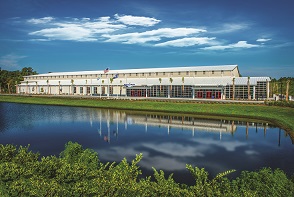
“There’s an ocean here that attracts everybody,” says Anderson, who came to Myrtle Beach from North Carolina, where for 12 years he was director of sports for Visit Charlotte. “When I was in Charlotte, I came here every summer with my children. I vacationed here. There’s so much to do in this market that anybody who wants a calm, very quiet getaway or a busy, jam-packed, crazy getaway, they can get either in Myrtle Beach, or anything in between.”
But Anderson has a message for you: Where sports are concerned, Myrtle Beach isn’t built on sand.
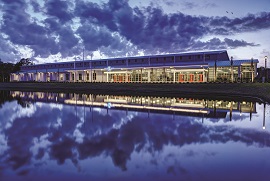 Don’t get him wrong: Sixty miles of beach is a huge asset. But it’s the local communities on and off the beach that combine to make Myrtle Beach more than just the city or the beach itself.
Don’t get him wrong: Sixty miles of beach is a huge asset. But it’s the local communities on and off the beach that combine to make Myrtle Beach more than just the city or the beach itself.
The Regional Sports Alliance brings in events that utilize facilities as far away as Georgetown, 35 miles to the south, to North Myrtle Beach, 16 miles away. Another attraction is the vast array of activities taking place before and after tournaments. (For information about local attractions, visit www.MyrtleBeachSports.com.)
500 Square Miles of Facilities
Myrtle Beach proper has the largest number and variety of facilities available to host events. Indoor court sports can take place within the Myrtle Beach Convention Center, comprising 250,000 total square feet of flexible space and 100,800 square feet of exhibit space, as well as in three of Myrtle Beach’s four city-owned recreation centers that include a full-size court for basketball or volleyball. An adjacent facility, the $12.4 million Myrtle Beach Sports Center, opened in 2015 and boasts 100,000 square feet of flexible indoor space that can accommodate eight basketball or 16 volleyball courts, as well as 2,000 spectators. It is configurable for numerous indoor sports.
Outdoor sports facilities within the city of Myrtle Beach include Grand Park Athletic Complex, with nine lighted turf and two natural grass fields, concession stands and batting cages, and Ned Donkle Field Complex, a seven-field, natural grass baseball/softball complex that also features a concession operation and batting cages. A third option for baseball is the Ripken Experience, with nine synthetic turf professional fields complete with scoreboards, retail options, concessions and batting cages.
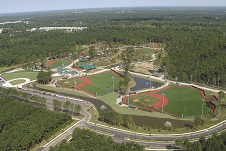 Myrtle Beach is also the location of Myrtle Beach Speedway, a 48-acre property with a 0.538 semi-banked asphalt track, grandstands that hold up to 9,000 spectators, a large semi-paved infield and one of largest outdoor amphitheaters in Horry County. It’s also the location of Ticketreturn.com Field, the 5,200-seat home of the Class-A Myrtle Beach Pelicans, a Chicago Cubs affiliate, and Doug Shaw Memorial Stadium – Ashley Booth Field, a synthetic-turf field ringed by an NCAA-certified, lighted track, and a spectator venue that seats 5,000.
Myrtle Beach is also the location of Myrtle Beach Speedway, a 48-acre property with a 0.538 semi-banked asphalt track, grandstands that hold up to 9,000 spectators, a large semi-paved infield and one of largest outdoor amphitheaters in Horry County. It’s also the location of Ticketreturn.com Field, the 5,200-seat home of the Class-A Myrtle Beach Pelicans, a Chicago Cubs affiliate, and Doug Shaw Memorial Stadium – Ashley Booth Field, a synthetic-turf field ringed by an NCAA-certified, lighted track, and a spectator venue that seats 5,000.
North Myrtle Beach is no slouch in the outdoor facilities department, either. Central Park can accommodate soccer and lacrosse on its one large and two small natural grass fields, baseball and softball on its three lighted youth diamonds, tennis on its four hard courts and even pickleball on its four outdoor courts. The North Myrtle Beach Park & Sports Complex has eight lighted natural grass multi-purpose fields and six lighted baseball/softball fields. There’s an indoor venue, as well: J. Bryan Floyd Community Center, with two basketball/volleyball courts.
Just 11 miles from Myrtle Beach, Coastal Carolina University (in Conway) has a range of state-of-the-art athletic facilities: The HTC Center, which features a gymnasium with seating for 3,212 for basketball; Brooks Stadium-Benton Field, which seats 9,214 spectators for football and lacrosse; Springs Brooks Stadium, a 2,500-seat baseball venue; CCU Softball Stadium, a natural grass venue with 251 chair-back seats; CCU Tennis Complex, which has 12 US Open-style hard courts surrounded by bleachers and rocking chairs; and CCU Soccer Stadium, a natural grass pitch with bleacher seating for 1,000 and an elevated standing-room-only area. None of these facilities dates from before 2002.
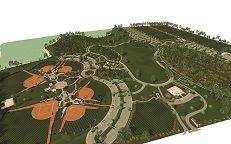 The Georgetown area has one major outdoor baseball venue, 8 Oaks Park, which has four 200-foot and two 300-foot lighted fields, and a multi-sport complex, Stables Park, which has a 5K certified cross-country course and eight hard court and two clay tennis courts in addition to its four grass fields. What it has that really adds to the stable of Myrtle Beach-area facilities, however, is Carroll Ashmore Campbell Marine Complex, a six-ramp tournament venue with saltwater and freshwater access, equipped with a lighted event stage. The marine complex is the location for two popular events, the Bassmaster Elite Series, which brings hundreds of the nation's top professional bass anglers to the area in the spring, and the IFA Redfish Championship, which takes place on the Intracoastal Waterway.
The Georgetown area has one major outdoor baseball venue, 8 Oaks Park, which has four 200-foot and two 300-foot lighted fields, and a multi-sport complex, Stables Park, which has a 5K certified cross-country course and eight hard court and two clay tennis courts in addition to its four grass fields. What it has that really adds to the stable of Myrtle Beach-area facilities, however, is Carroll Ashmore Campbell Marine Complex, a six-ramp tournament venue with saltwater and freshwater access, equipped with a lighted event stage. The marine complex is the location for two popular events, the Bassmaster Elite Series, which brings hundreds of the nation's top professional bass anglers to the area in the spring, and the IFA Redfish Championship, which takes place on the Intracoastal Waterway.
Sharing events in the various surrounding communities isn’t particularly rare. The Triple Crown Summer Baseball Nationals, World Fastpitch Connection World Series (baseball/softball), Big Shots Summer Nationals (basketball) and Coast FA Spring Classic (soccer) all take place at venues in both Myrtle Beach and North Myrtle Beach, and the Top Gun Winter World Fastpitch Series, a softball tournament, takes place in those two communities and in Georgetown.
One event that takes place just in North Myrtle Beach is High Tide Ultimate, the world’s largest collegiate spring break Ultimate tournament, which this year celebrated its 20th anniversary and for the second time was paired with the USA Ultimate-sanctioned Rip Tide weekend tourney. More than 200 college Ultimate teams from all over the country took part in 2016.
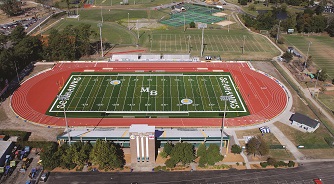 Just blocks from the Grand Strand in downtown Myrtle Beach, all types of events bring in thousands of participants and families and fill hotel rooms throughout the year, with much of the action taking place at the Convention Center. The Grand Strand Volleyball Club Winter Bump attracted 332 teams and more than 10,000 spectators for the 2016 tournament, with the more than 3,000 athletes representing eight states.
Just blocks from the Grand Strand in downtown Myrtle Beach, all types of events bring in thousands of participants and families and fill hotel rooms throughout the year, with much of the action taking place at the Convention Center. The Grand Strand Volleyball Club Winter Bump attracted 332 teams and more than 10,000 spectators for the 2016 tournament, with the more than 3,000 athletes representing eight states.
Myrtle Beach became the permanent home of the Cheer Ltd. Nationals at CANAM 26 years ago, which had been organized as an international championship between U.S. and Canadian teams that would alternate between cities in the two countries. However, the first Myrtle Beach event, in year two, scuttled that plan.
Another revered annual event, the Beach Ball Classic, began in 1981 as a showcase for top boys’ high school basketball teams — four from South Carolina and four from out-of-state. Today, the boys’ Beach Ball Classic and the girls’ Beach Ball Classic Holiday Invitational are each 16-team national tournaments and together make up the country’s premier high school holiday tournament.
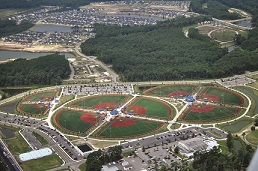 Everything Under the Sun
Everything Under the Sun
Anderson understands that the prevailing view of Myrtle Beach doesn’t stray far from the oceanfront, but he’s seeking to change all that, with a more expansive approach that brings the benefits of the region’s various communities to bear on sports. “In this area, everybody helps one another,” Anderson says, “and that’s important to what we’re trying to do. For example, we have more than 100 golf courses — there’s a reason Myrtle Beach is sometimes called the "Golf Capital of the World" — and only three or four are within the city limits of Myrtle Beach, so we have to make this an overall regional effort. If we’re going after a baseball event, even with 11 baseball fields in one location in the city of Myrtle Beach, we can give them 40 fields in a heartbeat. The city of Myrtle Beach has the largest number of facilities, but there are also many other parts of the Myrtle Beach region that are involved and engaged in this.”
The region’s facilities, Anderson says, are what set it apart from other well-known beach communities. “There are many incredible beaches, but they’re not Myrtle,” he says. “For sports, there’s no competition. I love my neighbors, but those places simply don’t have the infrastructure. We just have to make sure we don’t take things for granted — we have to continue to challenge ourselves in how we do business and do things better with what we have.”


There are no comments
Please login to post comments